Report

Executive summary
Riding on the back of tremendous economic growth in the past decade, India has now become the fifth-largest economy in the world. Not all this growth has been inclusive, however. The gap between the top 1st percentile and the bottom 50th percentile has continued to widen. In addition, the Covid-19 pandemic has pushed more than 200 million Indians into poverty. Although social sector funding in India, primarily driven by the government, has grown approximately 12% annually from approximately INR 10 lakh Cr. to about INR 17.5 lakh Cr. over the past five years, gaps remain. According to NITI Aayog, India needs to funnel approximately 13% of its GDP into social causes—the current average is about 7%—to achieve its United Nations (UN) Sustainable Development Goals (SDG) commitments by 2030.
Written in collaboration with
Written in collaboration with
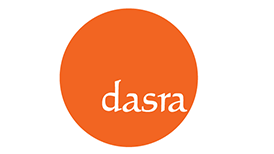
With state finances negatively affected because of the pandemic and government debt increasing, private philanthropy must realise its full potential and play a crucial role in bridging the gap. Overall private giving (domestic and foreign), however, has stayed relatively flat over the past few years, while private domestic giving has grown at a moderate pace (8% to 10% year over year [YOY]). Corporate social responsibility (CSR), family philanthropy (ultra–high-net-worth individuals [UHNIs] and HNIs), and retail giving cumulatively contribute about 84% of the total private philanthropic capital in India; they will act as three strong pillars as we move ahead.
CSR, driven by the 2% mandate, has grown at 15% annually in the past seven years, with its share in total private giving growing from approximately 12% in fiscal year (FY) 2015 to 23% in FY 2021. Riding on rapid economic growth, formalisation, and more companies coming under its umbrella, CSR contributions are expected to grow at 19% annually, with its share expected to reach about 32% of total private giving by FY 2026.
Family philanthropy, in contrast, has contracted overall. UHNI giving has decreased from the peak of 2016, while HNI giving has grown at a modest pace. Relative contributions (giving as a percentage of wealth) among Indian UHNIs range from 0.1% to 0.15% compared with 1.2% to 2.5% in the United States, 0.5% to 1.8% in the UK, and 0.5% to 1.4% in China. Overall, however, family philanthropy is expected to grow at a robust 13% per year until FY 2026, driven by increasing wealth and a rise in the number of technology entrepreneurs and NowGen philanthropists.
Retail giving in India is mostly unorganised and often an emotional and impulsive decision. It has grown at a modest 5% annually from INR 21,000 Cr. in FY 2015 to INR 28,000 Cr. in FY 2021, but with the ballooning middle class and the sheer growth in the number of donors, retail giving is expected to grow at approximately 10% annually and contribute one-fourth of total private giving by FY 2026. As we advance toward transforming India and propelling its growth story at the scale and pace needed, a real opportunity exists to invest in and support different funder groups across CSR, family philanthropy, and retail giving. To continue the momentum and further accelerate giving in India, it will be imperative to build on the short-term transformational potential of CSR, greater investment in building an enabling ecosystem for retail and high-potential HNI givers, and increased thoughtful social investments by NowGen philanthropists. All funder segments must be more knowledge led and flexible in their giving; they must engage with their grantee partners as equal stakeholders. Building a robust philanthropy infrastructure for all segments is critical for the next decade of India’s growth, and the institutional funders must invest in it.
The status of social sector funding
In the past decade, India has witnessed tremendous economic growth and been one of the world’s fastest-growing major economies. It is now ranked as the fifth-largest economy in the world in absolute GDP and the third-largest economy in terms of purchasing power. In terms of per capita GDP, however, it ranked 153rd in 2010 and increased only marginally to 144th in 2021. The trend has been further accentuated by the pandemic, which pushed more than 200 million Indians into poverty, widened the inequality gap, and hit disproportionately disadvantaged communities hard. These and other indicators establish that although the country’s economic trajectory has been strong, its development story can hardly be called inclusive. Progress and access to opportunities have missed the most vulnerable geographies and populations. It is imperative that the pace of action accelerate toward inclusive and sustainable development—now more than ever.
The total social sector expenditure in India has seen a robust 12% annual growth from approximately INR 10 lakh Cr. to about INR 17.5 lakh Cr. over the past five years. In fact, FY 2021 witnessed a sharp increase, with a 20% jump in total expenditure. Most of this rise, however, has been a result of increased government expenditure: public funds (central and state social expenditure) account for approximately 93% of the total, up from approximately 90% five years ago.
With the total supply of funds at an average 7% of GDP in recent years (8.3% in 2021, however), India is still short of NITI Aayog’s estimation of the total annual funds needed (approximately 13% of the GDP) to achieve its UN SDG commitments by 2030. The result is a deficit of INR 8 lakh Cr. for FY 2021 and INR 10 lakh Cr. for FY 2026 if the same trajectory continues. In fact, India’s social sector expenditure as a percentage of GDP is less than neighbouring countries and other BRICS countries, and some way behind Organisation for Economic Co-operation and Development countries (see Figure 1).
The glaring deficit of social sector funding in India must be plugged. As with any developing nation, the government has been taking most of this burden, but with increasing fiscal deficit and higher debt burden following the pandemic, government finances will be limited. It is here that private philanthropy comes into the picture, with its ability to bridge some of the gap if it realises its true potential.
The deficit in social sector funding in India can rise to ~INR 10 lakh Cr. by FY 2026 if the same trajectory continues

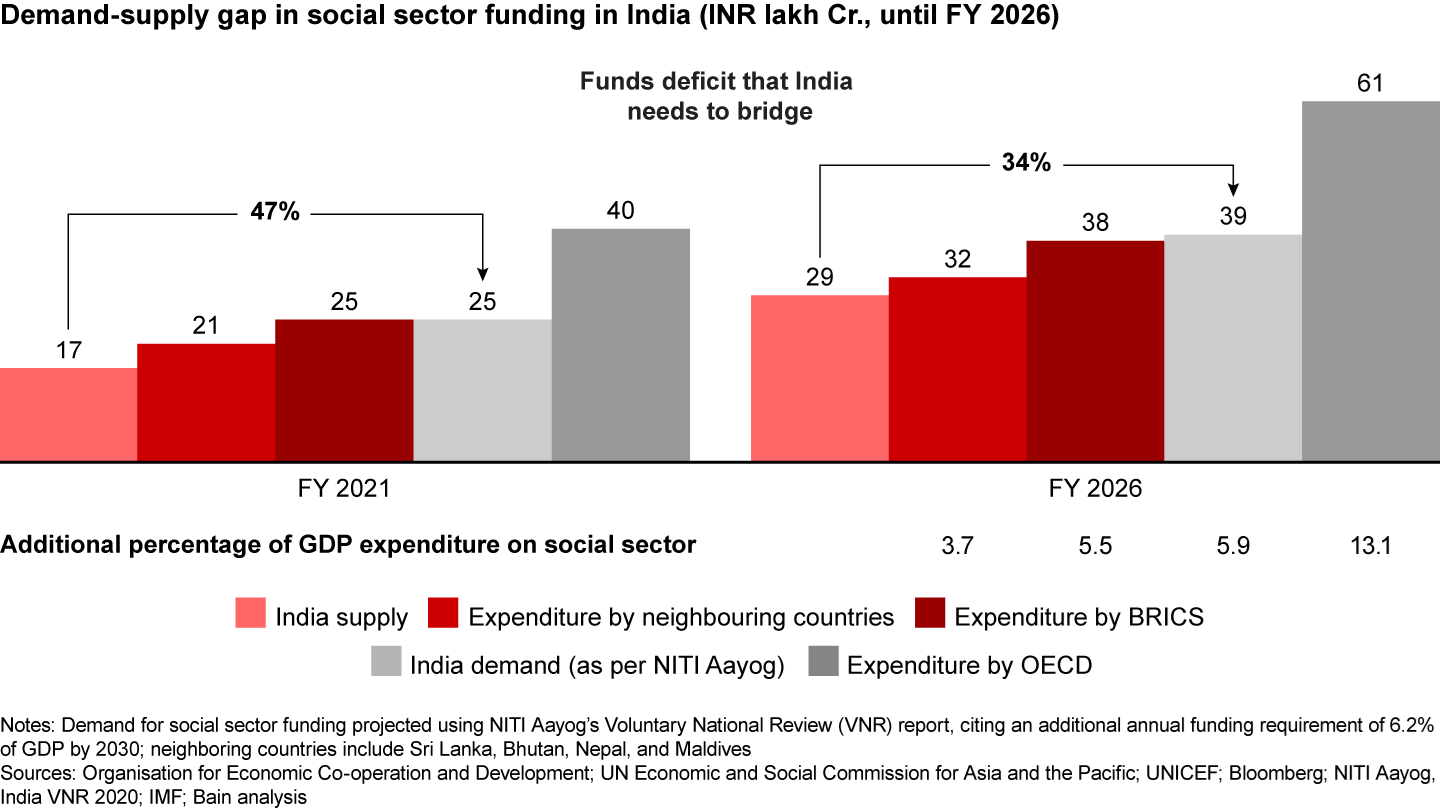
Private-sector funding stems from two major sources: foreign and domestic philanthropists. Domestic philanthropists include corporations (CSR and corporate trusts) and individuals. Domestic individuals can be further categorised into family philanthropy (UHNIs and HNIs) and retail depending on their net wealth or income and donation amount. Our research shows past trends and future projections for each of these sources (see Figure 2):
- overall private giving (domestic and foreign) has stayed relatively flat over the past five to six years (low single-digit growth), even before Covid-19 struck;
- private foreign giving has contracted (from approximately a 26% share in overall private giving in FY 2015 to approximately a 15% share in FY 2021), while private domestic giving has grown at a moderate pace (8% to 10% growth YOY), aided primarily by CSR contributions;
- CSR has steadily grown, both in absolute terms and in its contribution to overall private giving, which increased from 12% in FY 2015 to 23% in FY 2021;
- family philanthropy has contracted overall to form about one-third of the total private giving vs. approximately 37% in FY 2015;
- UHNI giving has contracted from its peak of 18% in FY 2015 to 11% of total private giving in FY 2021; and
- retail giving has grown marginally, but its overall share remains 25% to 30% in total private domestic giving. Retail giving is largely unorganised (peer-to-peer/community based) and, although growing overall, has the potential to become more organised.
India’s private funding breakdown by segment

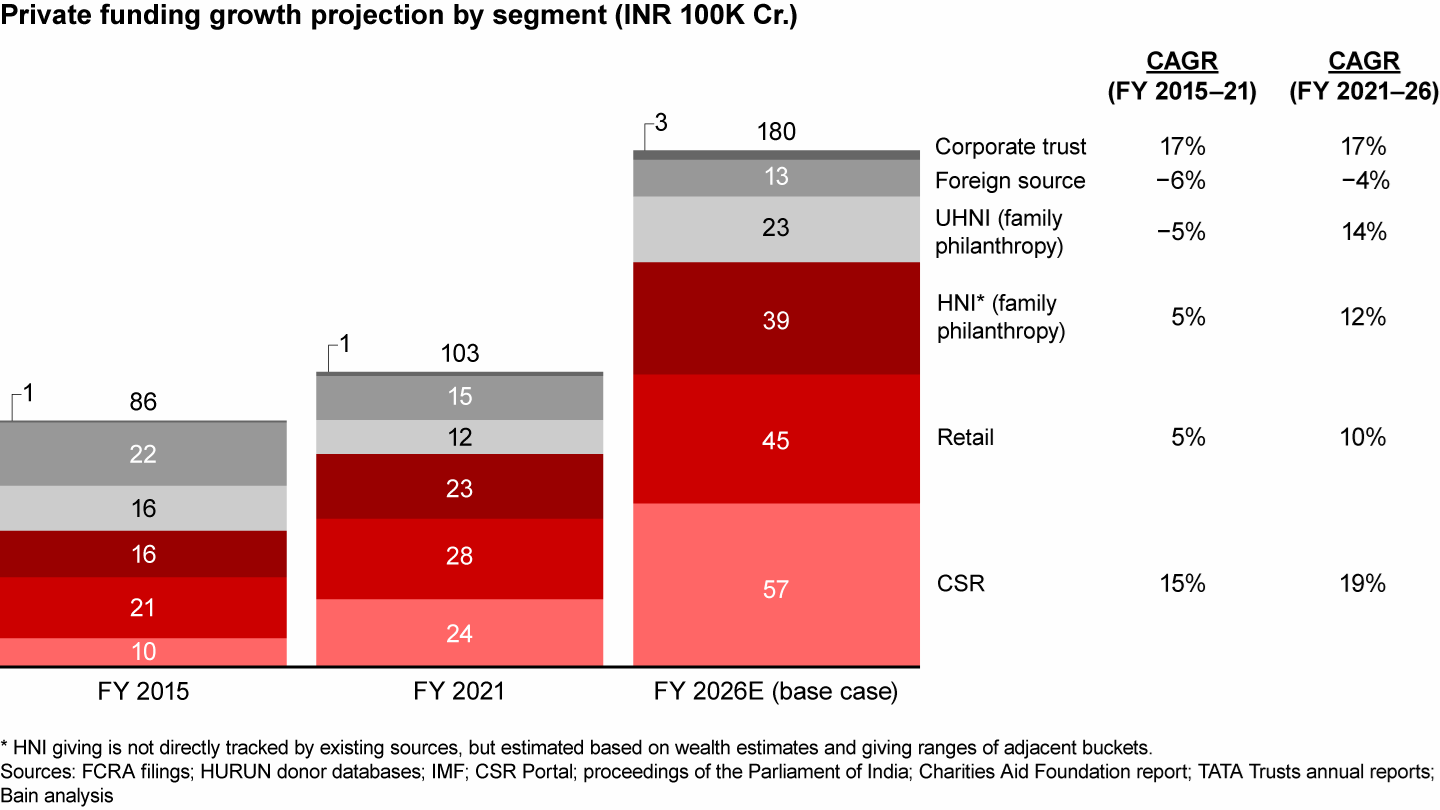
“Economic volatility and an increase in contributions to quasi-official funds coupled with lack of reliable information on where to give especially during Covid has affected the inflow of funds into the sector.”
Total private philanthropic funding in India is estimated to grow at approximately 12% annually in the next five years, riding on robust growth in the three main segments: CSR, family philanthropy (UHNI and HNI), and retail. The growth can be even greater if we can harness relevant enablers within each segment, as highlighted in the upcoming sections of the report. Private foreign funding could continue to contract, however, because of regulatory barriers. Corporate trusts can grow at 15% to 20% annually but still contribute a mere approximately 2% of total private funding.
Historically, CSR funds have grown at a faster pace than that of the economy. Robust future GDP growth accompanied by the 2% mandate and Bombay Stock Exchange 200 companies contributing approximately 50% to the total CSR spending point to strong future CSR contributions. The segment is expected to grow both in absolute terms and in its share of total private funding. Reasons for this projected trend include the expected rise in the Indian economy and India Co’s profits, a shift from an informal to a formal economy, an increase in the number of companies falling in the CSR orbit, and an increase in the number of companies spending more than the 2% mandate (approximately 140 companies contributed more than 3% in FY 2020).
Although family philanthropy may have less visibility and growth than CSR, it is expected to grow at a robust 12% to 14%, with both UHNI and HNI contributions blossoming. With a disproportionate increase in wealth during the pandemic and a possible increase in relative giving (giving as a percentage of net wealth) as more tech entrepreneurs and NowGen philanthropists enter the fray, this cohort holds the potential to play a crucial role in meeting the country’s social sector fund requirement. Flexibility in spending and long-term commitment of funds are key differentiators of this cohort and could improve further as younger entrepreneurs increase their donations.
Retail giving is another important pillar, constituting about one-fourth of total private funding despite the minor dip in the share from approximately 27% (FY 2021). Total retail donations are expected to reach approximately INR 45,000 Cr. in FY 2026, growing at a slower rate than the other two sources (possibly because of stickiness issues after Covid-19) but still a healthy approximately 10%. This increase will primarily be driven by strong GDP growth and robust growth in the Indian middle class. Moreover, increasing adoption of technology and the evolution of new platforms, such as crowdfunding, can accelerate the transition from traditionally informal giving (approximately 81% in FY 2021) to formal giving.
“Covid created an inflection point, particularly around how new funds such as ACT Grants came up, and it might be interesting to reflect on this and further explore such pathways.”
Private philanthropy in India is poised to grow with the projected growth in the economy, a rise in the number of donors across the segment, and growth in income and wealth. It is important to take advantage of these factors and focus on building a robust ecosystem that encourages giving and unlocks potential across the segments in the future.
Within the context of the overall trends, let’s delve deeper into the three major segments that account for approximately 84% of overall contributions and are expected to lead India’s private philanthropy moving ahead: CSR, family philanthropy (UHNI and HNI), and retail giving.
CSR mandates have built momentum
The CSR mandate began in 2014 and remains one of a kind, with India the only country mandating that corporations fulfill their social responsibility. Eligible companies are required to spend a minimum 2% of their past three-year average net profits on CSR activities. Average CSR giving has hovered around the same 2% mark over the years.
In other economies, such as the United States, CSR is a voluntary process. The minimum percentage defined in India provides a more structured path for corporate giving in addition to boosting its position vis-à-vis the United States, where corporate giving is less than 20% of total private giving. CSR activities in India have seen an upward trend, which is reflected in the increase in donations. From INR 10,066 Cr. in FY 2015 to an expected INR 23,665 Cr. in FY 2021, the segment has shown a robust CAGR of 15% in the past seven years.
In terms of the total number of companies contributing toward CSR, approximately 90% are unlisted. Further, only approximately 3% of companies spent more than INR 10 Cr. in FY 2020, whereas more than 70% of companies contributed less than INR 50 lakhs. Moreover, the number of companies spending INR 0 to INR 50 lakhs has grown approximately 15% from FY 2015 to 2020, pointing to a broadening of the CSR orbit and a rise in contributions by smaller companies. A similar trend is expected in the future because more companies are likely to fall under the CSR rule, driven by economic growth and formalisation.
“As key stakeholders in the development of India, corporates can do more. I believe there is room to have progressive tax slabs in CSR, just like our income tax structure. A company making INR 10,000 Cr. in profit can certainly give more than 2%.”
Of the three major sources of private giving, CSR is the most widely distributed across sectors in which funds have been donated toward more than 20 causes. In total, 70% of the total CSR spending over FY 2018 through 2021 went to education, healthcare, rural development, environmental sustainability, and poverty, which is much better compared with family philanthropy and retail (community giving), where approximately 60% of funds go to education and healthcare alone, respectively. Because of this wider spread, CSR also affects smaller sectors, such as sports, art and culture, animal welfare, and women empowerment, which struggle to attract funding from other sources.
In FY 2021, healthcare, boosted by funds allocated to the Prime Minister’s National Relief Fund, emerged as the focus sector for CSR because of the various Covid-19 relief activities organisations undertook. As a result of this reallocation, other sectors, such as education and rural development, witnessed a decline in their share of CSR funding (see Figure 3).
In FY 2021, increased spend in healthcare and PM Relief Fund from Covid-19 fund allocation; other sectors, such as education, rural development witness a fall

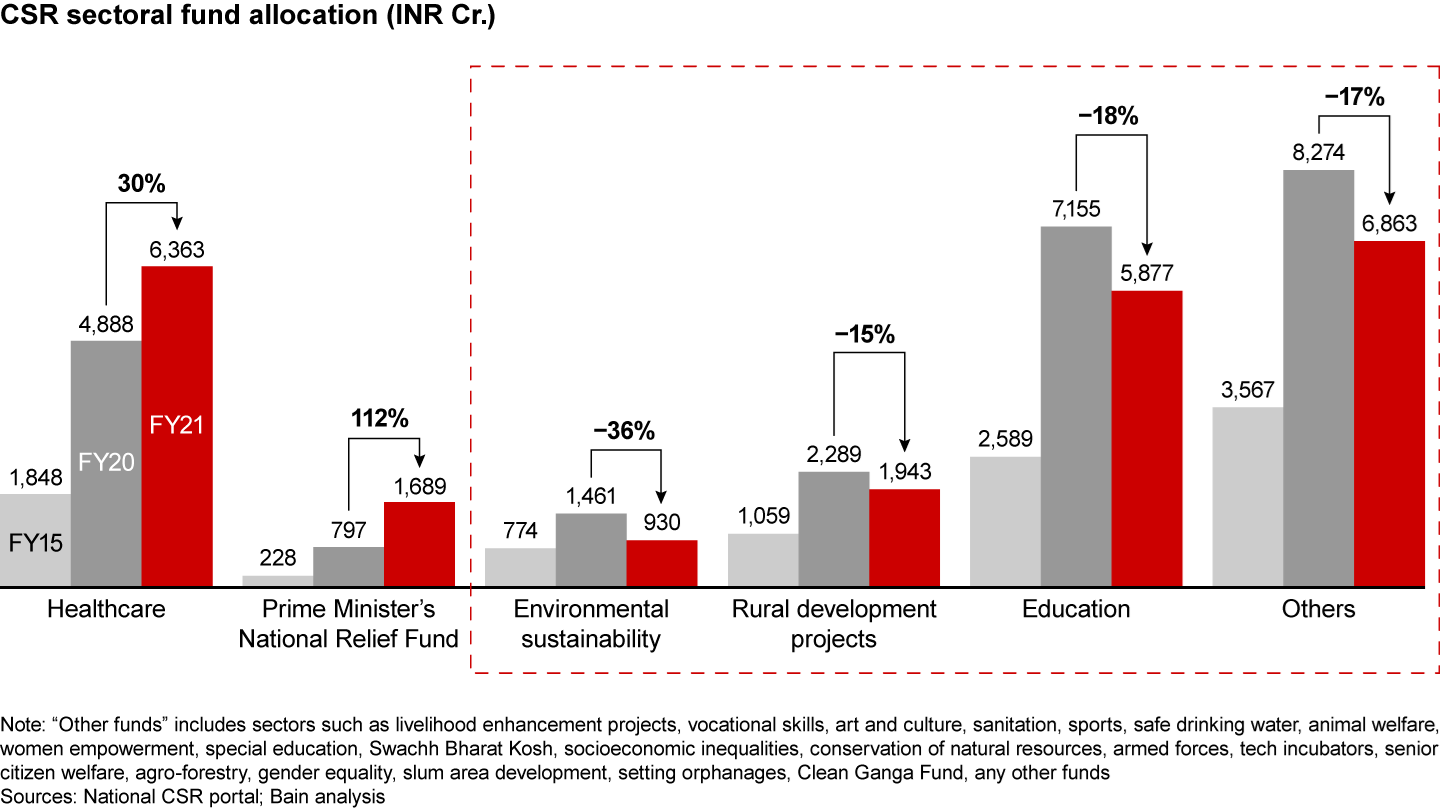
According to the Indian Ministry of Corporate Affairs, the amount currently spent on Covid-19 relief is eligible as a CSR activity. As a result, FY 2021 witnessed a large proportion of funds directed toward Covid-19 relief activities (approximately 40%), with a five-times increase in funds from INR 1,815 Cr. in FY 2020 to INR 9,225 Cr. in FY 2021.
With respect to geographical allocation, approximately 50% of CSR funds are distributed to 10 states, led by Maharashtra, Karnataka, and Gujarat, limiting the distribution of funds to cities in other states. States such as Uttar Pradesh, Kerala, and Himachal Pradesh are also gradually gaining funding, with 32%, 33%, and 48% growth rates, respectively, from FY 2015 to 2021.
“CSR now needs to move beyond cities. Money givers are willing to give to the work in the cities and also villages in Maharashtra, Gujarat, Andhra, Telangana, and some more states, but what about Uttarakhand, Bihar, Jharkhand, Meghalaya, and so many other states and regions where they don’t have business establishments and factories?”
A major challenge with CSR giving is the lack of an established institutional mechanism through which to deploy funds. Because companies tend to contribute funds in the vicinity of their company location, geographical bias, wherein fund allocation focuses more on cities than villages, creeps in. Lack of readily available organised data, knowledge of causes, and organisational due diligence pose a barrier to effective deployment of CSR funds.
Family philanthropy has not kept pace with wealth increase but holds future potential
Domestic individual philanthropy includes the two strong pillars of family philanthropy (UHNI and HNI) and retail donations. Unlike CSR’s positive trend, the story is not that simple here, with some segments reporting an increase and others stagnating or even reducing their contributions.
Family philanthropy overall forms about one-third of total private giving vs. approximately 40% in FY 2016. Division of the segment into UHNI and HNI giving shows differing trends, with UHNI giving exhibiting some volatility and reduction from its peak:
- total UHNI donations have declined by approximately 40% from their peak in FY 2016, but a four-times growth in the past two years signals a positive uptrend; and
- in terms of allocation, education has continued to garner the most funds (more than 60%), followed by healthcare in distant second. FY 2021 saw disaster relief taking over healthcare however, pointing toward rising Covid-19–related donations as a possible reason behind the current increase in donations (see Figure 4).
Education continues to be the top cause, but disaster relief has surpassed healthcare in the most recent year

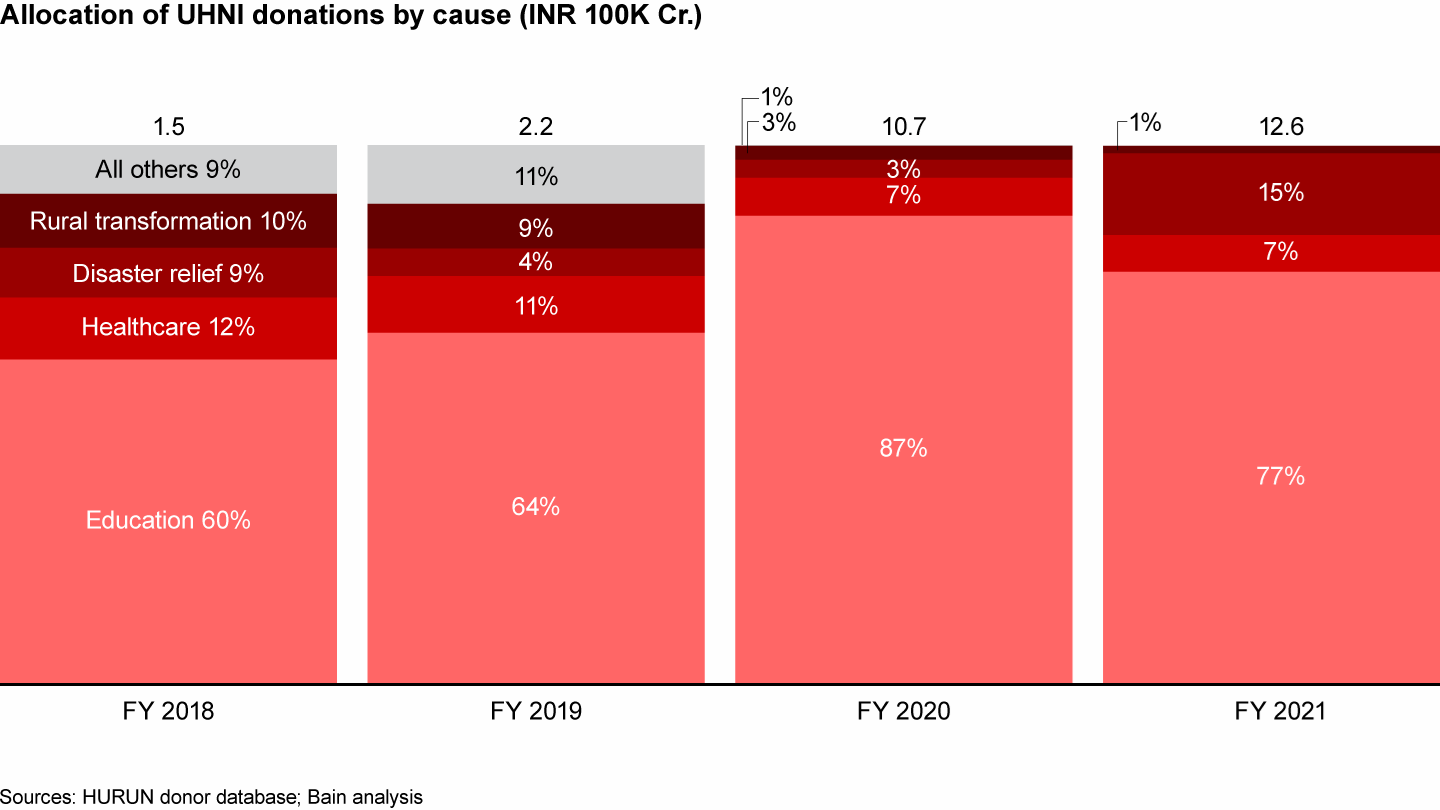
The fallacy of absolutes: A fall in UHNI giving as a percentage of net wealth, but some positives
Even though absolute UHNI giving has increased over the past two years, giving as a percentage of net wealth (excluding Azim Premji) has declined. One reason is a steep increase in the wealth of UHNIs following Covid-19: The number of individuals with wealth of more than INR 1,000 Cr. increased by approximately 20%, from 828 in FY 2020 to more than 1,000 in FY 2021, while their cumulative net worth increased by approximately 50%, from approximately INR 60 lakh Cr. to approximately INR 90 lakh Cr. in the same period. This trend was even more evident within the top wealth bracket, as the cumulative wealth of UHNIs in the more than INR 50,000 Cr. bracket rose by approximately 80% compared with an approximately 45% and approximately 30% rise in the INR 10,000 to INR 50,000 and INR 1,000 to INR 10,000 Cr. brackets.
Compared with China, the UK, and the US, Indian HNIs donate substantially less across all wealth brackets (see Figure 5). This trend can change, however, especially with the rise of Indian start-ups and young tech entrepreneurs. UHNIs from the technology sector have donated more generously than other sectors, constituting about 8% of the total UHNI wealth in 2021 but contributing to approximately 35% of total donations (see Figure 6), with similar trends noted in 2020. Multiple conversations with key stakeholders and initiatives such as the Young India Philanthropic Pledge, started by the Kamath brothers of Zerodha (who, in fact, were the youngest entrepreneurs ever to feature in the Hurun Rich List), seem to back this trend.
Average contributions of Indian UHNIs have been low across wealth brackets compared with other select geographies

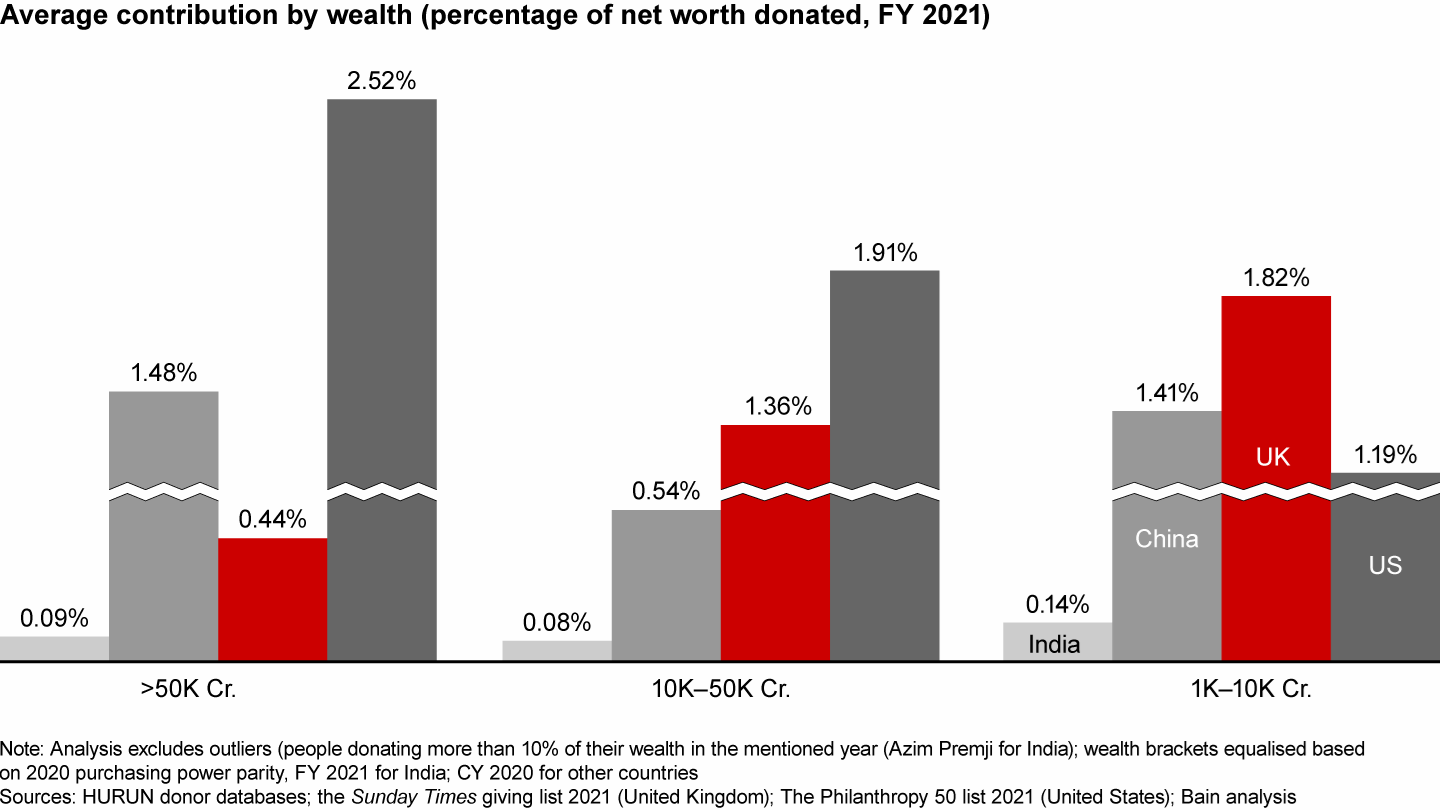
Technology and cloud services continue to outperform in terms of giving

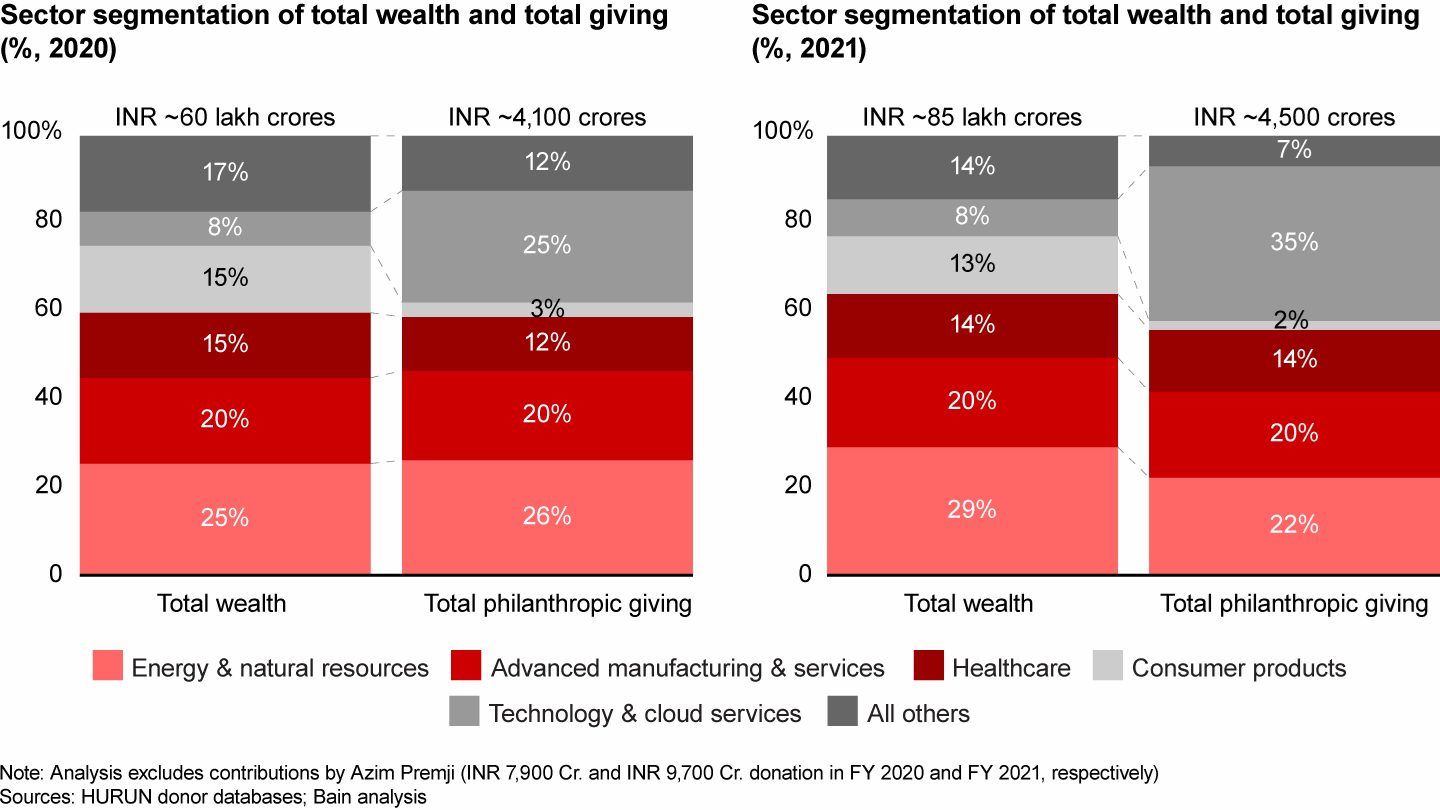
“The rise in new-age models of philanthropy, platforms such as Young India Philanthropic Pledge, and a growing number of institutions and intermediaries are playing a critical role in shaping and inspiring strategic and large-scale philanthropy … developments that can only bode well for the future of philanthropy in India.”
The scope for multifold increase in UHNI donations
Given these positive developments, Indian UHNIs could potentially increase their donations by 8 times, to INR 90,000 to INR 100,000 Cr., given that they match the percentage of giving of their UK and Chinese counterparts, and by 13 times, to INR 160,000 to INR 170,000 Cr., if they can match their US counterparts (see Figure 7).
Full potential donation by Indian UHNIs if they match their American, British, and Chinese counterparts

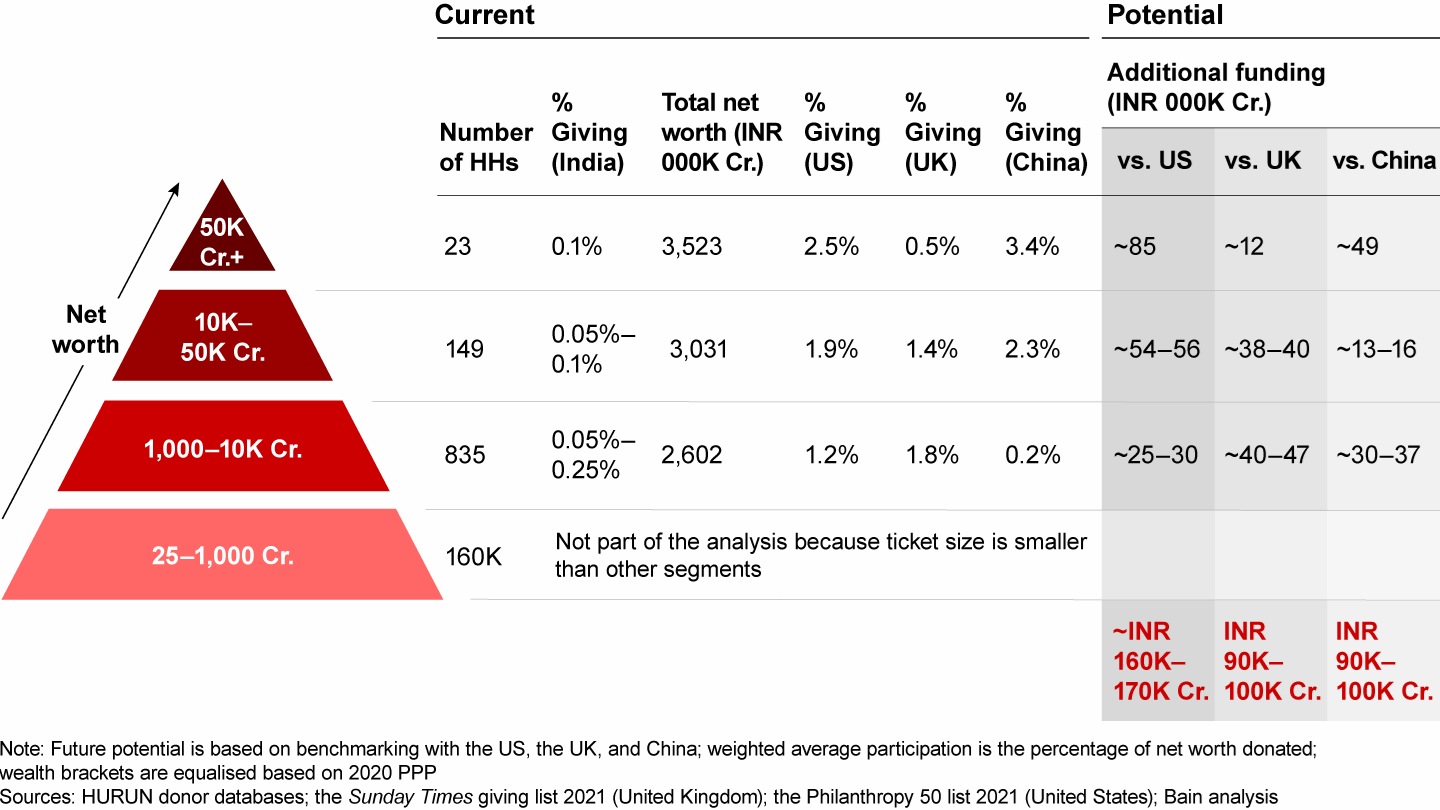
Unlike UHNI philanthropy’s huge swings, total HNI donations could be less volatile, growing at a CAGR of 6%, from approximately INR 16,000 Cr. in FY 2015 to approximately INR 22,000 Cr. in FY 2021. In the period mentioned, the number of affluent households has risen from approximately 280,000 to approximately 391,000, and the number of HNI households has increased from approximately 5,000 to approximately 8,000. Both segments have increased at approximately 6% CAGR over the past seven years, driven by upward movement among upper-middle-class families into the affluent category.
Growth of the stock markets and India Inc. profits, increasing inflow of foreign capital for investment, and a meteoric rise in value creation in the start-up ecosystem have all contributed to this phenomenon. This trend is expected to grow stronger as India strives to become a $5 trillion economy by 2030.
Lack of an enabling ecosystem could pose a challenge to future HNI giving
Most interviewees asserted that as wealth grows and more families engage in formalised philanthropy, there is a need for a curated ecosystem for this particular segment of givers, which is placed between UHNIs (whose donation sizes are usually large enough to justify setting up personal foundations or family offices) and retail givers (the segment on which most crowdfunding platforms are focusing). It is critical to harness the giving potential of this segment, which will keep growing as India reaps the benefits of economic growth.
“We see immense potential for family philanthropy over the next decade—unlocking it will need increased transparency and collaboration, evidence-based knowledge on credible giving opportunities, and stories of impact to inspire new givers.”
Retail giving could grow on the back of income, giving platforms, and digitisation
Everyday giving and community-led social change have been integral parts of India’s history and are deeply embedded in the culture. Unlike CSR and family philanthropy, retail donations are unorganised and nonsystemic in nature; they are often a result of emotional decisions and impulse action. Total retail donations have grown at a CAGR of 5%, from INR 21,000 Cr. in FY 2015 to INR 28,000 Cr. in FY 2021. Growth has been driven by upward mobility among households toward higher income groups between 2005 and 2018, with the majority of retail giving undertaken by high-income and upper-middle-income groups, both of which grew at 10% CAGR between FY 2006 and FY 2019 (see Figure 8). Generally, it has been observed that an increase in retail donations is a function of rising income and the number of donors.
Gradual shift of households across income groups will boost retail individual donations

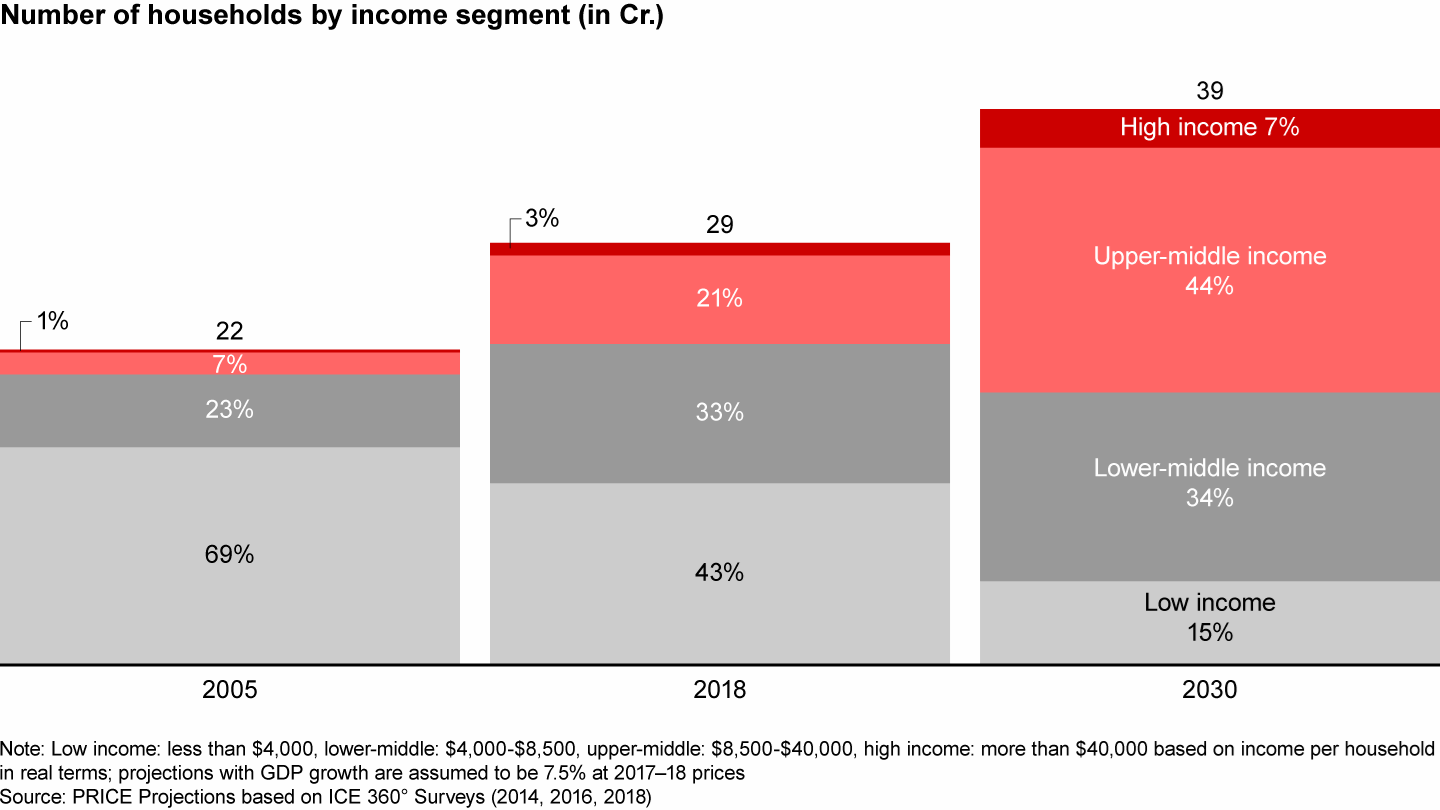
Retail donations take place through two major channels: formal and informal. Formal channels consist of retail donations to nongovernmental organisations (NGOs) and disaster relief funds (DRF), exemptions to which are available under Section 80G of the Income Tax Act. Such donations typically involve a direct monetary transfer from the donor to the NGO or DRF, with limited intervention by intermediate crowdfunding platforms such as Ketto and Milaap. These platforms are estimated to account for less than 10% of transactions by volume.
The informal segment covers everyday community giving to people in need. It is a direct form of help and proximate to the point of impact—for example, giving money to one’s community to help a family member in need of urgent healthcare. Over the past five years, crowdfunding platforms have disrupted this segment by offering greater accessibility, flexibility, and ease of payment to donors along with a substantially wider reach to individuals and charities raising money.
“In the midst of the disaster, crowdfunding infrastructure stood up and delivered. Anyone who wanted to give was able to, globally, with a single click. Easy-to-discover, reliable platforms were in place and were able to handle the scale. It is a good sign of where retail giving has reached in its evolution. However, these are still early days and a lot more needs to be done.”
The crowdfunding market is still in its nascent stages in India and is minuscule in size compared with that of other countries, such as France, the UK, Canada, and the US. The estimated size of gross crowdfunding donations raised in the UK and France is approximately seven to eight times that of India.
The sluggish growth of the Indian crowdfunding sector can be attributed to limited penetration of digital payment methods and excessive regulatory barriers. Primarily, there are three types of crowdfunding: donation based, debt based, and equity based. In India, equity crowdfunding is illegal, and debt-based crowdfunding (person-to-person lending) faces intense scrutiny from the Reserve Bank of India.
Crowdfunding shows immense potential as a key vehicle for channelising retail donations in the future. The power of crowdfunding can be seen by the volume of resources these platforms mobilised during the two deadly waves of the pandemic. Platforms such as Ketto and ImpactGuru registered four-times and two-times growth, respectively, during the pandemic-induced lockdown.
In both formal and informal channels, increasing digitisation of donations is a common emerging theme. Lockdowns and social distancing norms have also facilitated an increase in online donations. One survey highlights that 44% of Indians interviewed preferred using digital wallets compared with 28% in 2019. The number of people making donations online with cards has also been increasing, from 33% in 2018 to 35% in 2019 and 40% in 2020.
Formalisation of the retail donation landscape—that is, an increase in formal donations as a proportion of total retail donations—is an interesting trend that can be observed over the past five years. Formal donations have grown from approximately 10% in FY 2017 to approximately 20% in FY 2021 on the back of factors such as increasing incomes and the advent of crowdfunding platforms (see Figure 9).
The share of formal donations has doubled in the past three years; considerable scope for formalisation still exists

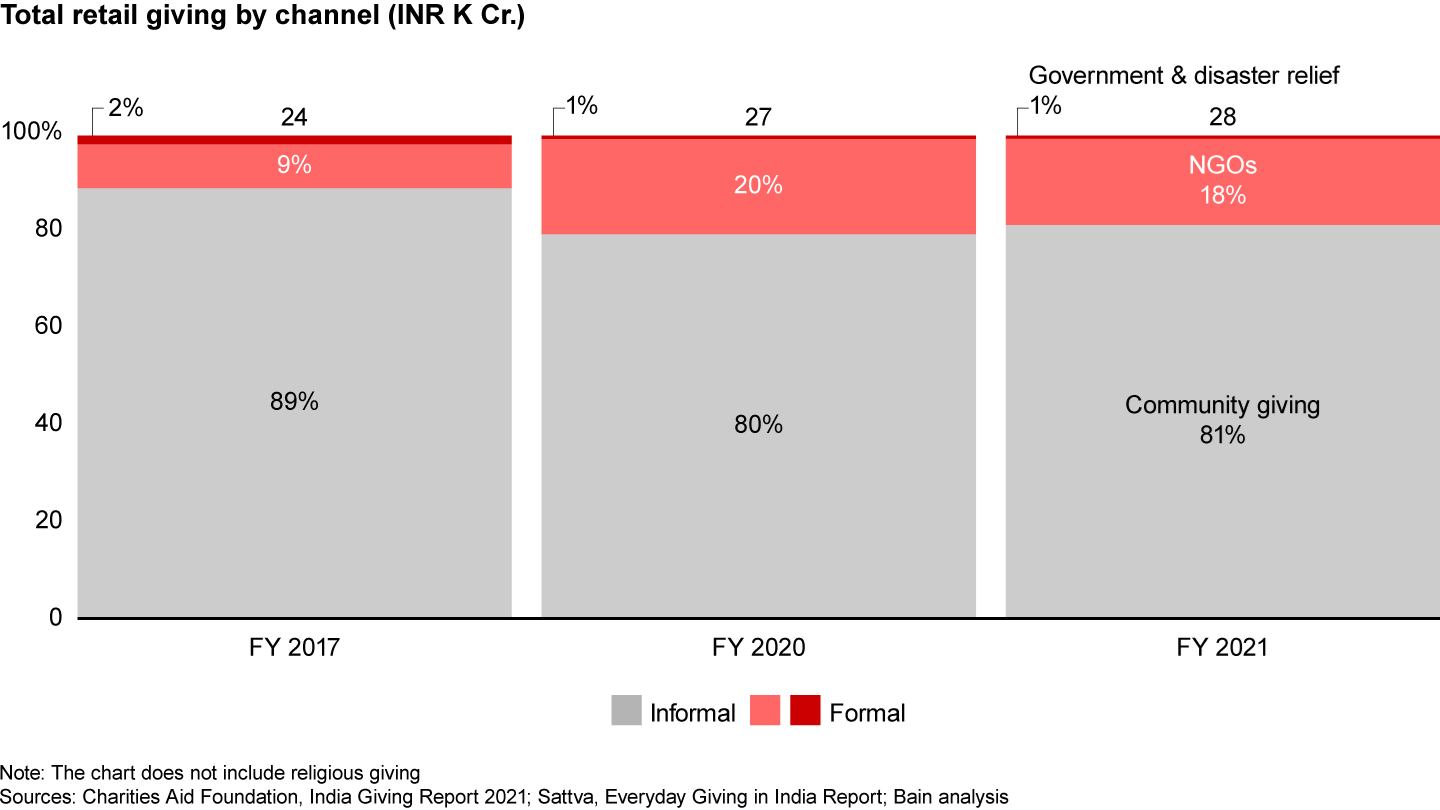
Although India has shown progress, a massive opportunity remains to formalise the sector. Studies show that tax incentives can play a positive role as well. For example, following an increase in incentives in Singapore from 200% to 250% in 2009, a 7% increase in individual donors was observed. Another intriguing approach to expand retail individual donations is instilling innovative practices such as donation matching within corporations. An organised way of donating wherein the employer matches the employee’s contribution to a specific cause could help people come forward and donate. It is important to improve donors’ experience through innovative solutions (appealing to the need for customised donation requirements across causes, organisations, events, etc.). Focusing on enhancing flexibility, convenience, and impact visibility for the donors will be crucial in the future.
How to unlock more equitable funding
CSR has the potential to be transformational in the short term; a deepening of the approach will help. Recent CSR mandates have opened the gateway to a larger, more predictable annual inflow of funds to the social sector. Additionally, stakeholders point to several corporations that went beyond the mandate to support communities during the pandemic, be it through cause marketing or promoters adding their private wealth to their corporate giving. With the growing emphasis on environmental, social, and governance reporting, corporations over the years have formalised and structured their CSR mandates, often involving business leaders and senior management in decision making and seeking CSR advisory groups to shape and manage their giving.
Although CSR has certainly evolved over the years, sector leaders emphasise the need for three shifts:
- for corporations to pass on the flexibility they enjoy under the CSR law to NGOs, especially as it relates to moving beyond the traditional geographical constraints that CSR often demands;
- for donors to consider longer-term commitments of three to five years based on priorities on the ground; and
- for business leaders to exercise their influence to promote corporate giving best practices, especially within networks such as the Federation of Indian Chambers of Commerce and Industry, the Confederation of Indian Industry, and Family Business Network.
“In India, the methodology and mindset of giving have still not been reimagined. Bangladesh, on the other hand, is a great example in developing a philanthropic strategy, for when they reach middle-income status in the next six to eight years. We’ve got a lot to learn.”
Positive momentum created by the pandemic among retail givers needs to be strengthened over the next decade
The pandemic prompted a rise in retail giving and brought new donors into the ecosystem through online crowdfunding platforms. As income increases, sector leaders assert that retail givers will gradually move from informal to formal modes of giving and seek more transparency in how their funds are being used. This shift calls for greater investment in the retail ecosystem across three key areas: expansion of causes beyond healthcare; innovating with recurring giving models, such as subscription-based monthly giving, leading to more involved giving vs. impulse giving; and creating stronger impact feedback loops with givers to encourage repeat giving. Retail giving affords significant flexibility to organisations as a funding channel; therefore, enhancing the ecosystem to support this segment will be key in the next decade of Indian philanthropy.
A high-potential segment that lacks a supportive ecosystem
The infrastructure to support microlevel and UHNIs continues to evolve, but the annual giving potential among the segment of HNI family philanthropists in the range of INR 50 lakh to 5 Cr. has yet to be served. With new wealth being created in the country, there is a greater need to understand the profile of this cohort—their interest areas, motivations, and barriers to giving.
This segment needs an enabling ecosystem of knowledge-vehicles networks—reliable, organised data and knowledge about sectors and organisations that can accelerate giving decisions; shovel-ready opportunities across causes and giving levels; and platforms to understand and learn from giving journeys of peers. This group is widely scattered; investing in a combination of technology and networks to create a range of platforms, vehicles, and tools will enable this segment of givers to use their networks, talents, and assets toward philanthropy and creating impact. In turn, the request from this segment is that givers be more ready to take risks, provide flexible capital, and use their influence to unlock resources from their peers and networks.
“Intermediaries can do a lot—connect corporates to good NGOs, facilitate linkages among various stakeholders, and educate families on how to best deploy their philanthropic resources.”
NowGen givers are emerging as the promising torchbearers of Indian philanthropy
Family philanthropy is becoming more visible and slowly shifting away from charitable work in the form of funding food, education, and scholarships to newer concepts and deeper focus areas. This shift is the result of the higher risk appetite of NowGen philanthropists, who are more entrepreneurial, socially aware, and innovative in their approach. It is critical to provide hands-on support to this promising cohort so that they can spearhead India’s journey to achieve SDG.
Indian NGOs need to invest in institutional capabilities for more effective funder engagement and to create stronger feedback loops with funders
Given their proximity to grassroots community groups and understanding of local realities, NGOs have played a critical role in supporting the most vulnerable communities through the pandemic, enabling last-mile connections where government services were unable to reach those in need.
As NGOs scale their reach within communities, there is a need for them to raise funding for and invest in institutional capabilities, particularly impact reporting, fundraising, and using technology and social media for strategic communications. This, of course, makes the case for more funders to allow for institutional funding within their grants so that NGOs can build teams and capabilities for deeper and greater funder engagement.
As we move beyond Covid-19 relief efforts, there is a growing need to create resilient, shockproof grassroot nonprofits so that the communities they serve can be empowered to rebuild and become resilient themselves.
“I urge funders to place greater trust in local NGOs, enabling them to become nimble, responsive, and resilient organisations. This requires a different form of funding, one that is flexible, long-term, and covers the real costs required for NGOs to meet the community’s ever-changing needs.”
Need for all funder segments to be knowledge driven, provide flexible capital, and engage with NGOs as equal stakeholders in their collective journey for impact
Although all funder segments have evolved and deepened their giving approaches over the years and we have seen more instances of co-creation among funders and NGOs, especially during the pandemic, there are three clear missions for all of them. First, let on-the-ground contexts and realities influence their giving decisions rather than top-down approaches; second, provide flexible funding so that the NGO can deploy it where it will be most effective for the communities; and finally, have a dialogue with the NGO as an equal stakeholder in this journey, not to view the NGO as a beneficiary but engage with it as an expert implementation organisation most proximate to the needs and challenges of vulnerable communities. Understanding and weighing in on their perspective while making funding decisions is key not only to stronger, more sustainable NGOs but to more sustainable impact.
“The intent to be more flexible and proximate in their giving is great, but we are yet to see it really happening to a significant extent. I hope funders continue this dialogue, take action themselves, and inspire their peers to do the same.”
Institutional funders must invest in strengthening the ecosystem for all funder segments
Based on projections, CSR, retail, and family philanthropy are set to grow by approximately 10% to 14% in the next few years. There continues to be an information-expectation-priority asymmetry in the sector: Investing in strengthening ecosystems will help address that asymmetry and unlock greater, more equitable philanthropy. Some of the key tactics are as follows:
- access to robust and reliable data on funders and NGOs;
- a diverse range of shovel-ready and fully designed vehicles for giving;
- easy access to high-quality, well-organised insights and thought leadership;
- access to high-quality, bespoke strategy advice; and
- greater transparency and standardisation of impact metrics.
Sector leaders also suggest that although tax incentives may encourage giving as a desirable behavior and unlock greater capital, it is not the underlying driver for philanthropy. This further accentuates the need to invest in philanthropy infrastructure and create an inspiring, audacious movement to establish giving as a social norm in the country. We are today at a critical juncture, not only to understand but also to carry forward the momentum and potential of each cohort in pushing forward the country’s development. The time to build a robust infrastructure to accelerate giving in India is now.